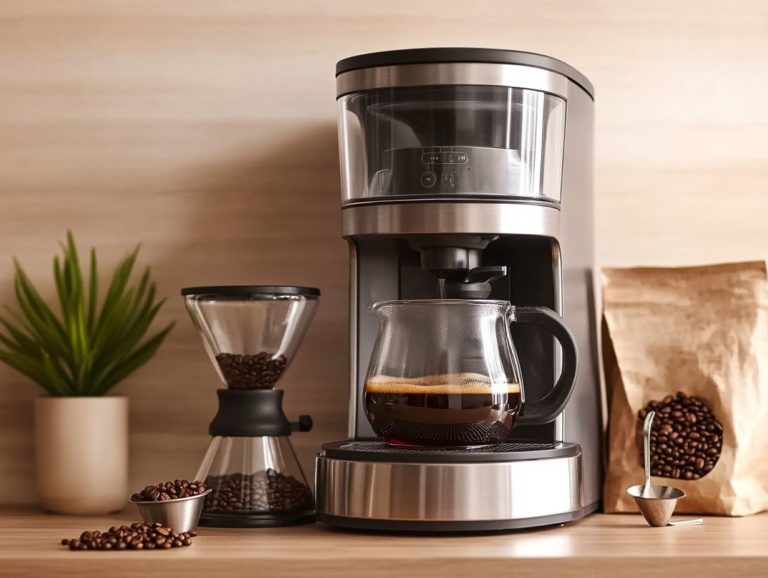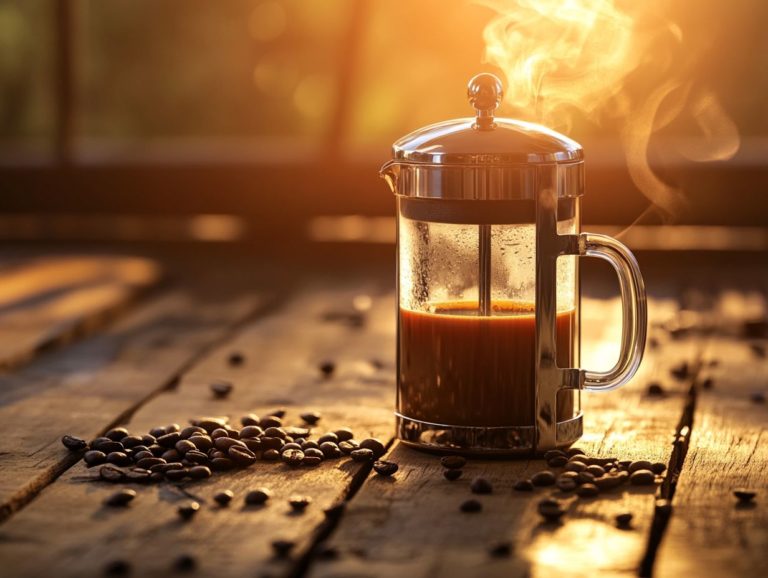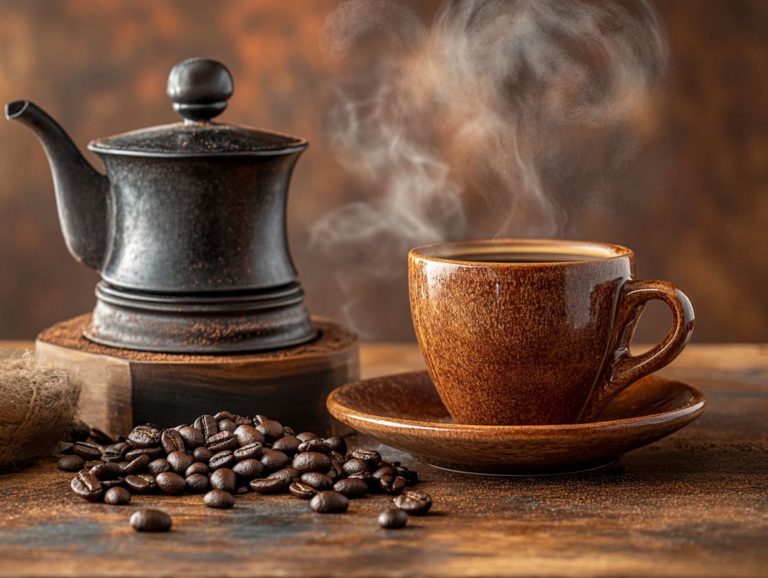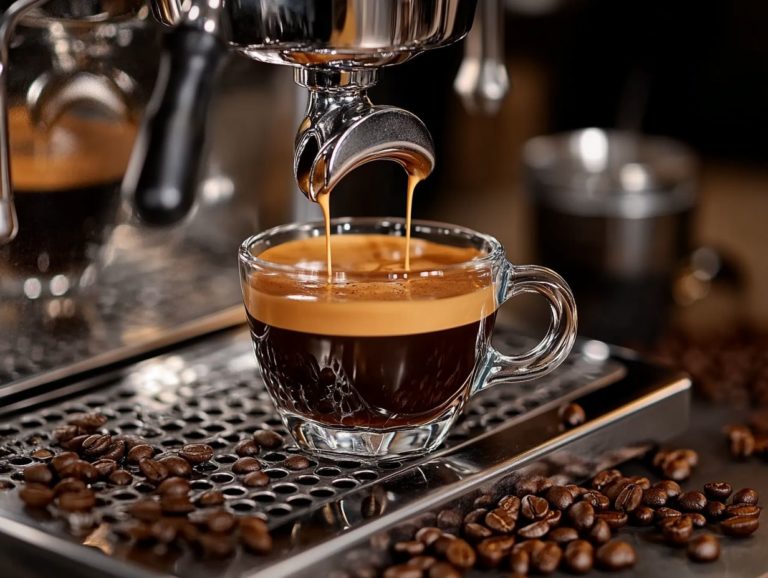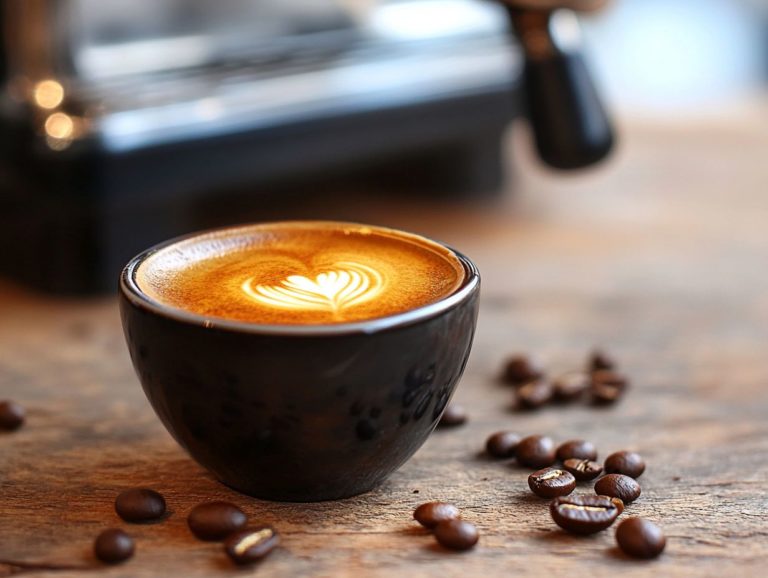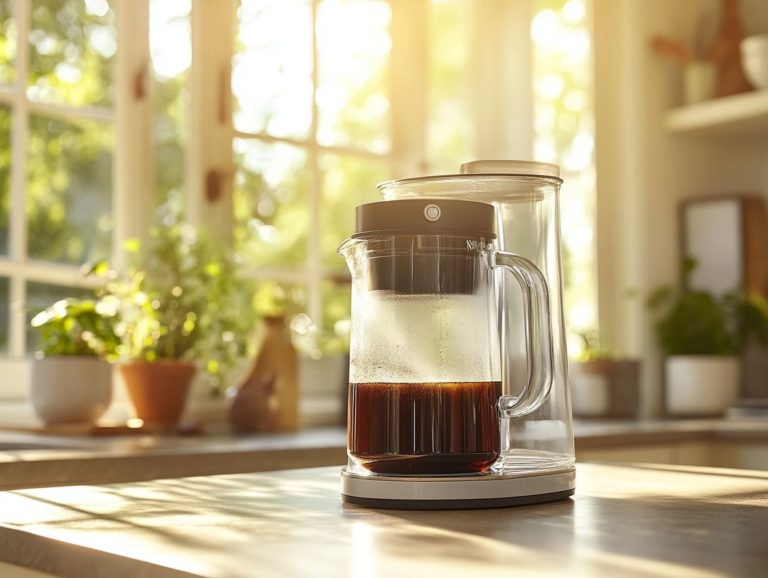Comparing Brewing Times for Different Methods
Brewing the perfect cup of coffee is a delicate dance between art and science. One of the most critical factors in achieving great taste is the brewing time.
Understanding how long to brew your coffee can make a world of difference in its strength, smoothness, and caffeine content, directly influencing the overall coffee quality.
This guide delves into various brewing methods from the classic drip brewing to refreshing cold brew and examines how each technique influences your coffee’s flavor profile. Whether you’re a casual drinker or a discerning coffee connoisseur, you’ll discover valuable insights that unlock the secrets of brewing time, enhancing your coffee ritual.
Contents
- Key Takeaways:
- What is Brewing Time?
- Why is Brewing Time Important?
- What are the Different Methods of Brewing Coffee?
- Brewing Times for Various Coffee Methods
- Which Method Produces the Strongest Coffee?
- Which Method Produces the Smoothest Coffee?
- Which Method Produces the Most Caffeine?
- Which Method is Best for Different Taste Preferences?
- How Can You Adjust Brewing Time to Achieve Your Desired Strength and Flavor?
- Frequently Asked Questions
- What is the role of coffee roasters in the coffee experience?
- What are some coffee recommendations for different brew methods?
- What are the different methods for brewing coffee?
- How do the brewing times vary between these methods?
- Which brewing method is the quickest?
- Are there any benefits to using a longer brewing time?
- Can I use the same type of coffee for all methods?
- What factors can affect brewing time?
Key Takeaways:
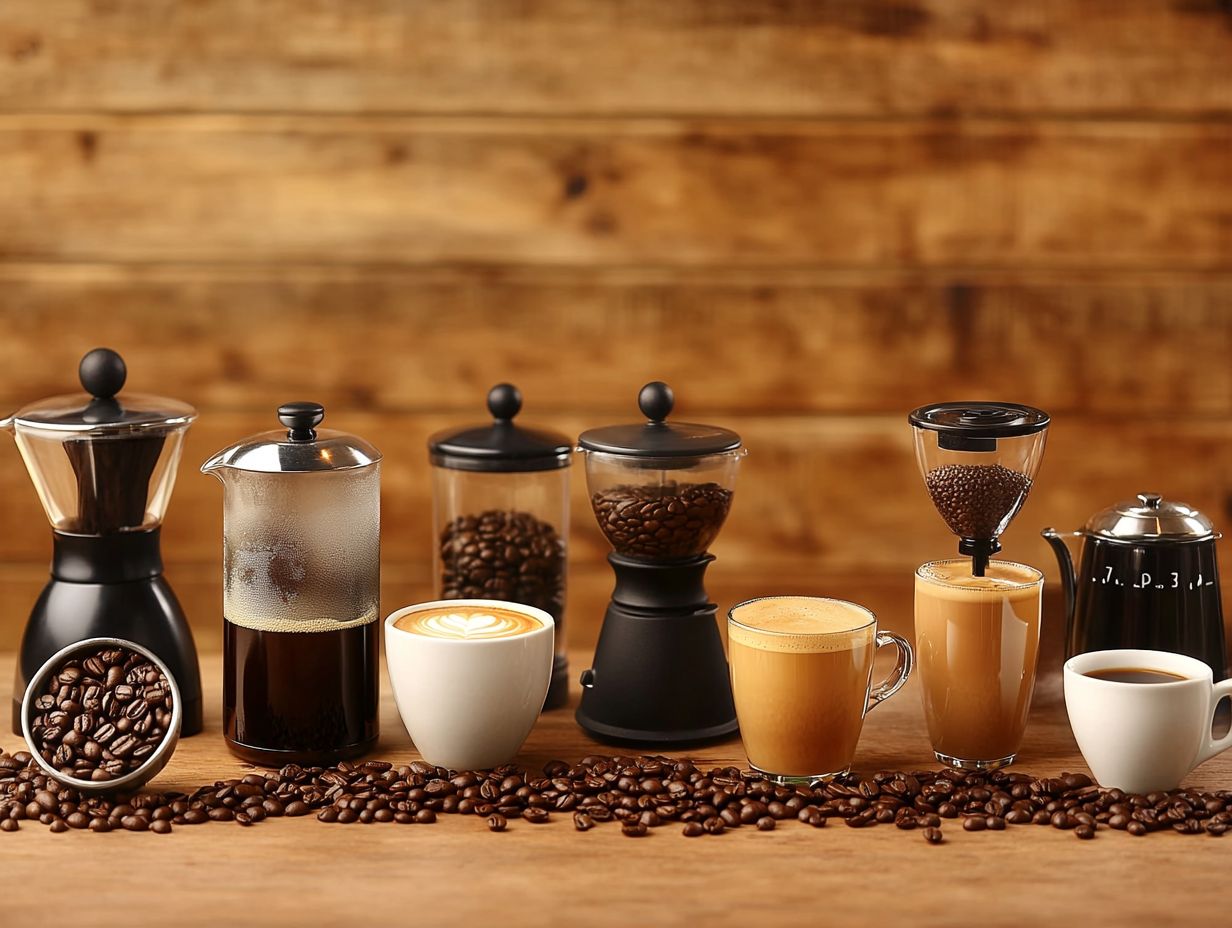
- Brewing time is the duration it takes to make a cup of coffee using different preparation methods.
- It affects the strength, flavor, and caffeine level of your coffee, shaping the overall experience.
- The longer the brewing time, the stronger and more bitter the coffee will be.
What is Brewing Time?
Brewing time plays a crucial role in the coffee-making process. It significantly influences how flavors and aromas are extracted from the coffee grounds. It refers to the length of time water interacts with the coffee, allowing different methods be it drip coffee, French press, AeroPress, or pour-over to develop their distinct profiles.
Understanding brewing time enhances the quality of your coffee, resulting in a richer body and a cleaner cup. Whether you lean towards medium roast or dark roast, mastering brewing time can elevate your coffee experience, tailoring it precisely to your taste. This knowledge is vital for both roasters and coffee lovers.
Why is Brewing Time Important?
Brewing time is a crucial element that impacts the quality and flavor of your coffee, shaping the effectiveness of the extraction process. When you nail the right brewing time, you unlock the coffee’s true potential, allowing those subtle flavors to come to life.
If you brew too little or too much, you risk encountering bitterness or under-extraction. Understanding this relationship empowers you as a coffee enthusiast to fine-tune your techniques, ensuring the highest quality and efficiency in your cup, ultimately elevating your coffee experience.
Different brewing methods like espresso, pour-over, and French press each have specific extraction times that dramatically influence taste. For example, the quick extraction of espresso captures vibrant acidity and rich aromas, while a longer steeping time in a French press yields a fuller-bodied cup brimming with deeper, complex flavors. This understanding is key for better brewing efficiency and flavor perception.
By adjusting your brewing time based on the chosen method, you can make a noticeable difference in flavor perception, allowing you to explore and savor the diverse characteristics of various coffee beans. Trust the Specialty Coffee Association’s guidance to perfect your brewing methods.
What are the Different Methods of Brewing Coffee?
Coffee enthusiasts embrace a variety of brewing methods to craft their perfect cup, each offering a distinct experience and coffee profile.
Techniques such as French press, AeroPress, pour-over, and drip coffee each influence extraction rates and clarity in unique ways. Immersion methods like cold brew deliver a rich body and velvety texture that is hard to resist. By mastering these methods, you can make well-informed coffee recommendations to others.
Familiarizing yourself with these brewing techniques allows you to confidently suggest options that resonate with individual taste preferences, elevating the coffee experience for yourself and others.
1. Drip Brewing
Drip brewing stands as one of the most popular methods for preparing coffee, seamlessly harnessing a coffee machine to automate the process while ensuring that flavors are consistently extracted. You simply pour hot water over ground coffee beans, and gravity takes over, guiding the brewed coffee through a filter and into a carafe below. The result? A clean cup with minimal sediment, ideal for those who appreciate coffee clarity.
With a range of designs and efficiencies, drip coffee machines have become a cherished companion for coffee lovers, prized for their convenience and reliability.
You ll find various types of drip coffee machines available, from basic models to more advanced options complete with programmable settings and built-in grinders. The choice of filter paper or metal plays a crucial role in shaping the final taste. Paper filters yield a crisp flavor by trapping oils, while metal filters allow for a richer body and depth.
Brewing variables such as water temperature, grind size, and brew time can greatly impact flavor extraction, leading to unique profiles and delightful aromas. Although drip brewing excels in ease and consistency, it may lack the complexity and depth often found in other methods like French press or pour-over brewing.
This intriguing balance of convenience versus flavor complexity makes drip brewing a beloved choice, albeit one that is sometimes overlooked by discerning coffee enthusiasts.
2. French Press
The French Press is your go-to immersion brewing method if you re looking to extract robust flavors and achieve a richly satisfying cup of coffee. This traditional technique involves steeping coarsely ground coffee in hot water for several minutes before you press down the metal or plastic plunger, effectively separating the grounds from the brewed coffee. The result? A full-bodied cup with a thicker texture that captures essential oils, elevating your flavor experience. This is a prime example of full immersion brewing.
By embracing this method, you can indulge in a nuanced tasting journey marked by pronounced aromas and a medley of flavor notes that often get lost in other brewing techniques. To truly maximize flavor extraction, it s essential to use a grind size that leans toward the coarse side; a grind that s too fine can lead to over-extraction and an unwelcome bitterness.
Your ideal brewing time should hover around four to five minutes, striking the perfect balance to allow your coffee to steep without tipping into excessive bitterness. Additionally, don t hesitate to experiment with different coffee-to-water ratios and fine-tune your steeping times. This exploration can lead you to discover your perfect cup, tailored uniquely to your taste preferences, enhancing your coffee brewing guide.
3. Pour Over
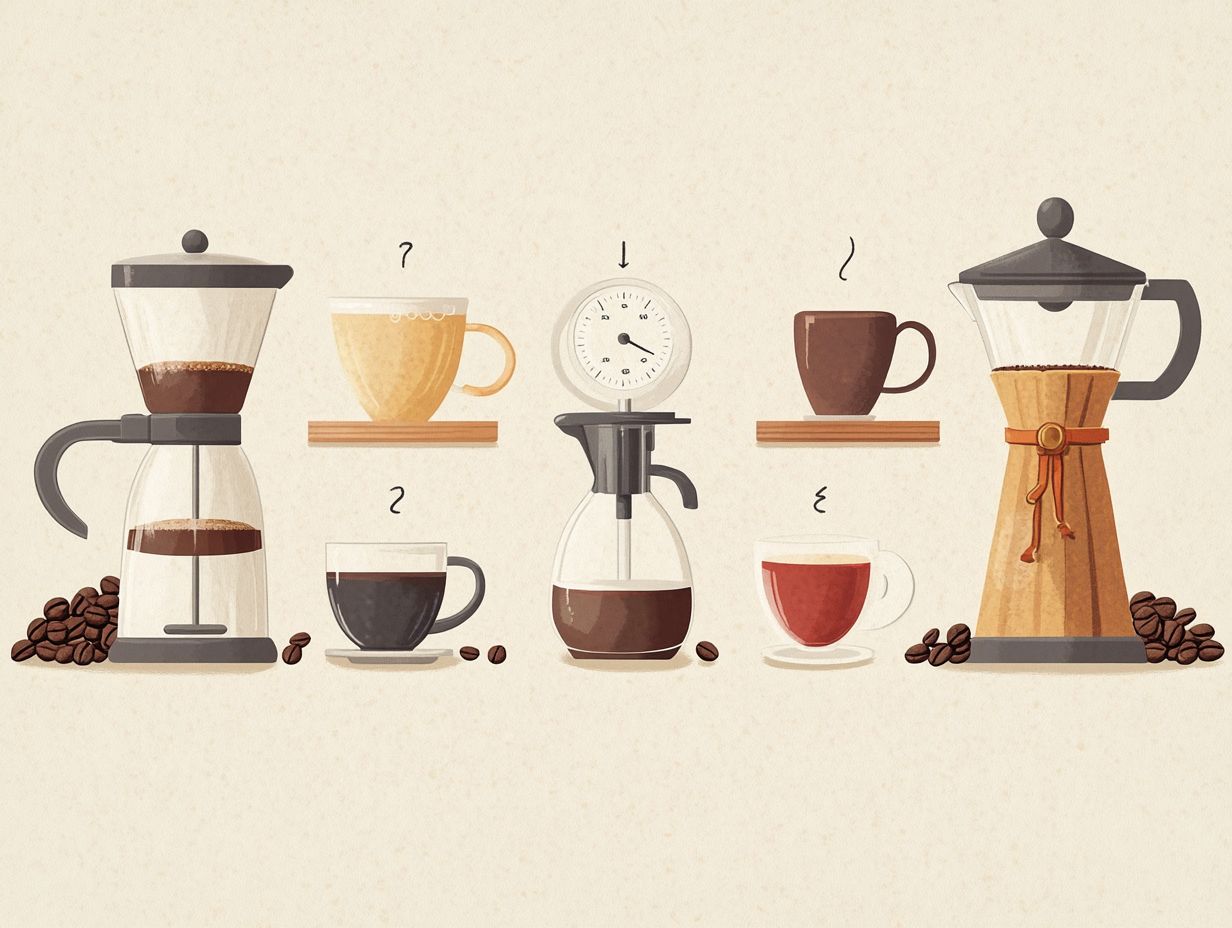
Pour-over brewing is your gateway to a truly refined coffee experience, allowing you to take charge of essential brewing variables like water temperature and pouring technique. This hands-on approach yields a clean cup with remarkable clarity, inviting both baristas and coffee aficionados to explore various coffee varieties and grind sizes to perfect their brew. Devices like the Chemex, Hario V60, and Stagg X-XF are renowned for their effectiveness in this method.
Devices like the Chemex, Hario V60, and Stagg X-XF are not just tools; they’re designed to elevate flavor perception through precise extraction and a delightfully smooth finish.
Grasping how these devices shape your final cup is crucial. For instance, the Chemex employs thicker filters that create a cleaner taste by adeptly removing oils and sediment, while the V60 s clever design enables quicker extraction, highlighting distinct flavor notes. Mastering water temperature is equally vital aim for a range between 195 F to 205 F to extract optimal flavors without the bitterness, ensuring a high-quality coffee brewing process.
Strive for an extraction time of around 2 to 4 minutes to achieve that perfect balance. Don’t hesitate to experiment with different filter types, as they can unlock unique flavors and mouthfeel, making pour-over brewing an exceptionally versatile method for coffee lovers like you. This method is highly favored by specialty coffee enthusiasts.
4. Cold Brew
Cold brew is an exceptional coffee brewing method that invites you to steep coarsely ground coffee in cold water for an extended period, typically ranging from 12 to 24 hours. The result? A smooth and mellow flavor profile that s hard to resist.
This immersion brewing technique significantly reduces acidity, allowing you to enjoy a rich body and a naturally sweet coffee experience. It s no wonder that cold brew becomes a go-to choice during the warmer months. It is perfect served over ice or with a splash of milk for a truly refreshing coffee treat. This method is often recommended by coffee roasters for its unique profile.
The allure of cold brew extends beyond its refreshing qualities; it offers a delightful canvas for flavor customization. You have the opportunity to experiment with different steeping times to adjust the strength of your brew a longer steeping period can deepen the coffee’s character beautifully.
Selecting the appropriate grind size is equally important; opting for a coarser grind helps prevent over-extraction, ensuring your coffee remains smooth and enjoyable, free from any bitterness. Cold brew is a testament to the versatility of coffee brewing methods.
In terms of serving your cold brew, the possibilities are endless. Elevate your drink by adding exciting flavored syrups or spices for a unique twist! You can even transform it into cocktails or creamy coffee concoctions. With such versatility, cold brew becomes a charming choice that caters to a variety of taste preferences, making it a favorite among coffee lovers. Don’t miss out on this refreshing treat during the hot summer months!
Brewing Times for Various Coffee Methods
The time it takes to brew coffee can vary greatly depending on the method you choose. Each technique has its own unique brewing times essential for achieving the best flavor and quality. Understanding these times is crucial for coffee preparation and efficiency.
For example, if you opt for a traditional drip coffee machine, expect it to take approximately 5 to 7 minutes. Meanwhile, a French press typically requires about 4 minutes of steeping to reach its full potential.
If you prefer the pour-over method, you ll need to exercise a bit more precision. This process usually takes around 3 to 4 minutes to complete. If you re in the mood for cold brew, be prepared to wait brewing it can take anywhere from 12 to 24 hours for optimal results.
1. Drip Brewing
Drip brewing typically takes between 5 to 7 minutes, making it one of the quickest methods for preparing coffee, especially when using automated machines designed for efficiency.
During this time, hot water flows through your ground coffee, extracting the rich flavors and enticing aromas to yield a clean cup with consistent quality. Several factors can significantly influence your brewing duration and, as a result, the flavor profile of your coffee.
For instance, the grind size is crucial; finer grinds generally release more flavor but can also prolong the brewing process due to the increased resistance against the water flow.
The type of filter you choose can also impact how quickly water saturates the coffee grounds; a thicker filter might slow down brewing while ensuring clarity in taste. The design of your machine, such as water distribution and temperature control, can also optimize or hinder the extraction process.
To enhance your brewing efficiency, it s essential to experiment with these variables and discover a balance that produces a flavorful cup within your desired time frame.
2. French Press
The French press method typically requires about four minutes of steeping time, allowing the coffee grounds to fully immerse and extract their rich flavors before you press.
Getting the brewing time just right is essential; over-extraction can lead to bitterness, while under-extraction leaves you with a lackluster coffee profile. Timing is key, as it directly influences not only the flavor but also the body and mouthfeel of your brew.
To elevate your experience, opt for a medium-coarse grind size; finer grinds can result in a murky texture and increased sediment in your cup.
Using water heated to a range between 195 F and 205 F will help you achieve the perfect extraction without scalding the coffee. This thoughtful balance of time, grind size, and water temperature transforms a simple brew into a rich, aromatic experience that beautifully showcases the unique characteristics of the beans.
3. Pour Over
Pour-over methods typically require about 3 to 4 minutes to brew your coffee, depending on how strong and clear you want it. Timing is crucial here; it ensures that the water fully saturates the coffee grounds and extracts those optimal flavors, resulting in a clean and nuanced cup that delights the palate.
You ll find that variations in water flow rate can significantly affect how the grounds interact with the brewing water, impacting the overall extraction process. A slower pour might give you a fuller body, while a faster flow can introduce brighter acidity but runs the risk of under-extraction.
Don t overlook the grind size of your coffee beans, as it plays a vital role in your brewing success. Coarser grinds will need a longer brew time for proper extraction, while finer grinds can produce quicker results but require careful attention to avoid any bitterness.
By mastering these factors, you can elevate your coffee experience, crafting a tailored flavor profile that perfectly aligns with your individual tastes.
4. Cold Brew
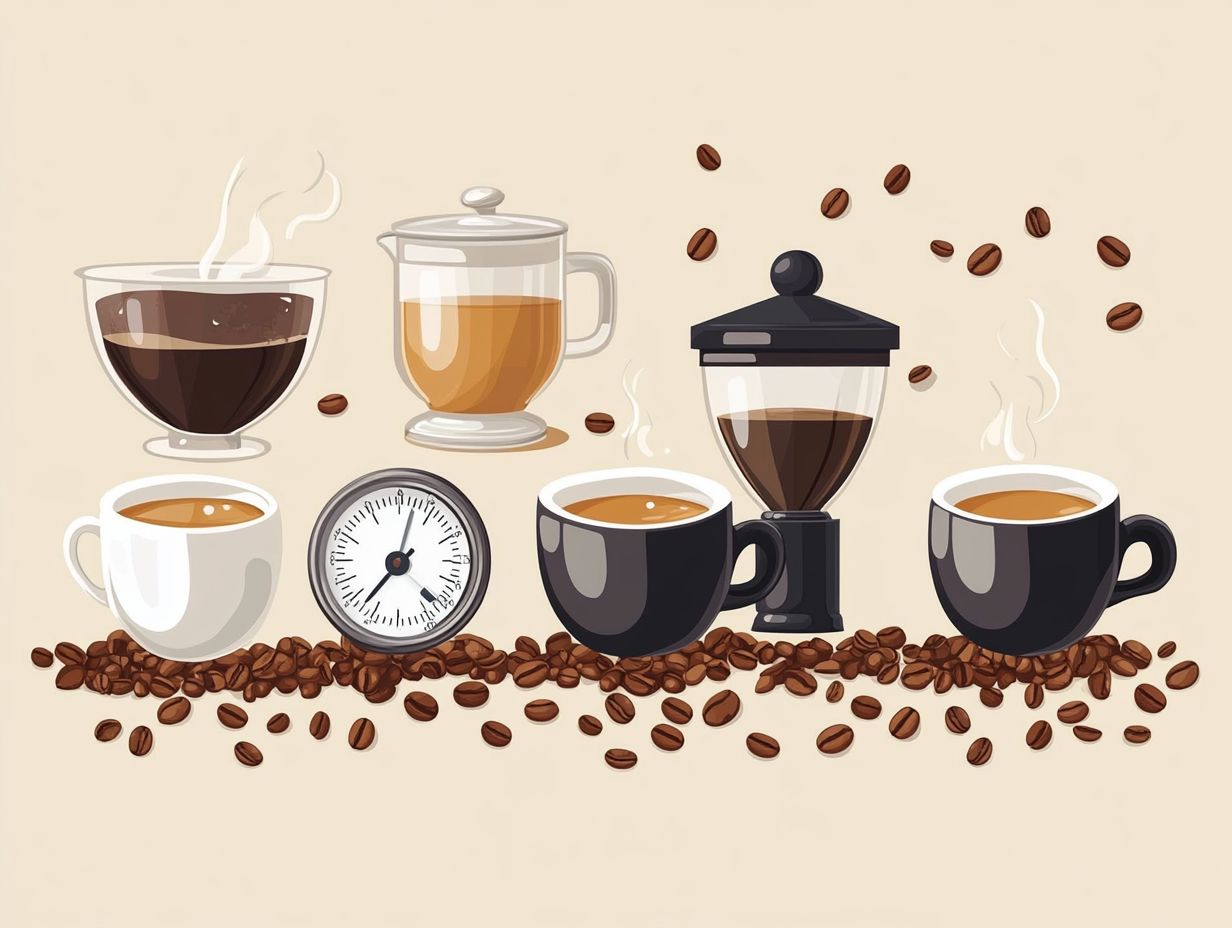
Cold brew stands out because it demands an extended brewing time, usually between 12 to 24 hours, to develop its signature smoothness and low-acidity flavor profile. This immersion brewing method invites a gentle extraction, resulting in a coffee concentrate that you can dilute and savor in various delightful forms.
To master the art of cold brew, it’s essential to grasp how steeping time affects both flavor and body. As the coffee grounds steep for an extended period, they gradually release their oils, sugars, and other soluble compounds, culminating in a rich and complex taste that can vary dramatically depending on the coffee variety you choose.
When you’re ready to make cold brew, start by coarsely grinding your favorite coffee beans and combine them with cold or room temperature water in a ratio that appeals to your personal taste. After the steeping period has elapsed, strain the mixture, allowing you to explore different coffee origins and roast profiles, each imparting its unique characteristics that enhance your overall cold brew experience.
Which Method Produces the Strongest Coffee?
When you evaluate which brewing method produces the strongest coffee, espresso clearly takes the crown due to its concentrated extraction process. With high pressure and a fine grind size, espresso machines deliver a bold coffee profile packed with intense flavors and a rich body all in a remarkably short brewing time. This method’s efficiency and depth make it a go-to choice for coffee enthusiasts like you who seek a robust coffee experience.
In contrast to the French press, which offers a gentler extraction over a longer duration, espresso’s pressurized technique yields a concentrated shot, often crowned with a thicker crema. This crema not only enhances the richness but also safeguards the delicate flavor compounds that might otherwise be lost in coarser brewing methods like cold brew.
If you’re aiming to perfect your espresso shots, paying close attention to grind size, water temperature, and extraction time is essential; these factors significantly influence the overall taste. Using freshly roasted beans and ensuring your equipment is spotless can elevate the espresso experience to new heights.
Which Method Produces the Smoothest Coffee?
Cold brew is often celebrated as the method that produces the smoother coffee, boasting a low acidity and a rich flavor profile. The extended steeping process allows for a gentle extraction, minimizing bitterness while highlighting the coffee’s natural sweetness. This results in a delightful drinking experience that resonates with many coffee aficionados.
This unique cold brew method truly distinguishes itself from other brewing techniques like French press and pour-over, where extraction often leads to more pronounced acidity and sometimes a harsher taste. While the French press method gives you a heavier body thanks to its immersion style, it can occasionally result in a gritty texture. In contrast, pour-over brewing provides you with precise control over water flow and extraction time, yielding a clean cup, yet it may lack that smooth, full-bodied quality that cold brew enthusiasts cherish.
Ultimately, the meticulous approach to extraction in cold brew not only emphasizes a softer mouthfeel but also unveils nuanced flavor notes that elevate your coffee experience to new heights.
Which Method Produces the Most Caffeine?
When you consider caffeine content, espresso undoubtedly leads the pack per ounce. However, due to its petite serving size, you might consume more caffeine through methods like cold brew or drip coffee, which serve larger volumes. The brewing method plays a significant role in caffeine extraction, so understanding the details of each technique is essential for any caffeine enthusiast.
Espresso
Espresso, crafted under high pressure with finely ground coffee, typically packs about 63 milligrams of caffeine per shot (1 ounce).
Drip Coffee
In contrast, a standard 8-ounce cup of drip coffee can deliver around 95 milligrams or even more, depending on the coffee-to-water ratio and brewing time. This can result in a greater overall caffeine intake per serving.
Cold Brew
Cold brew, often steeped for an extended period anywhere from 12 to 24 hours can yield higher caffeine concentrations compared to traditional methods, frequently exceeding 200 milligrams in a standard serving.
Thus, your total caffeine consumption varies not just by the preparation method but also by the quantity served. This makes it vital for coffee lovers like you to select your brewing methods wisely, tailoring them to meet your caffeine requirements.
Which Method is Best for Different Taste Preferences?
Choosing the best coffee brewing method often hinges on your taste preferences, as each technique showcases distinct flavor profiles and qualities. If you relish rich, full-bodied coffee, you might be drawn to methods like French press or espresso. Conversely, if you lean toward brightness and clarity, pour-over or drip brewing may be more your style.
You ll be amazed at how each brewing technique reveals unique flavor notes and elevates the overall coffee experience. For instance, using a finer grind in a pour-over brew allows delicate flavors to shine through, making it perfect for those who appreciate the subtleties of single-origin coffees. On the flip side, coarser grinds in methods like cold brew yield smoother, sweeter notes, catering to those who prefer a milder acidity.
Don t underestimate the importance of brewing time; a longer steeping period in a French press can amplify bitterness, while a quick extraction in espresso highlights richness and complexity. By experimenting with these variables, including grind size and water temperature, you can uncover a personalized cup that aligns perfectly with your taste profile and brewing preferences.
How Can You Adjust Brewing Time to Achieve Your Desired Strength and Flavor?
Adjusting your brewing time is a fundamental way to customize your coffee s strength and flavor, allowing you to fine-tune your brewing techniques for optimal results. Shortening the brewing time can yield a lighter, brighter cup, while extending it typically produces a richer, more robust flavor profile. By understanding the balance between brewing time and coffee extraction, you can craft the perfect cup tailored specifically to your preferences and flavor perception.
It s crucial to consider the brewing method you re using, as each technique has its own ideal steeping times. For instance, with pour-over methods, a shorter brew of around two to three minutes can enhance those delightful floral and fruity notes, resulting in a clean cup. On the other hand, if you re a French press enthusiast, a steep of four to five minutes may deliver a velvety body and depth that you ll cherish. Alternatively, an AeroPress can offer a quick and versatile brewing experience.
Experimentation is key here; begin with these suggested times and adjust in small increments based on your personal taste, coffee quality, and the specific beans you re working with. Keeping detailed notes on your brewing times, coffee profile, and the resulting flavors will help you refine your skills and consistently achieve the outcome you desire.
Frequently Asked Questions
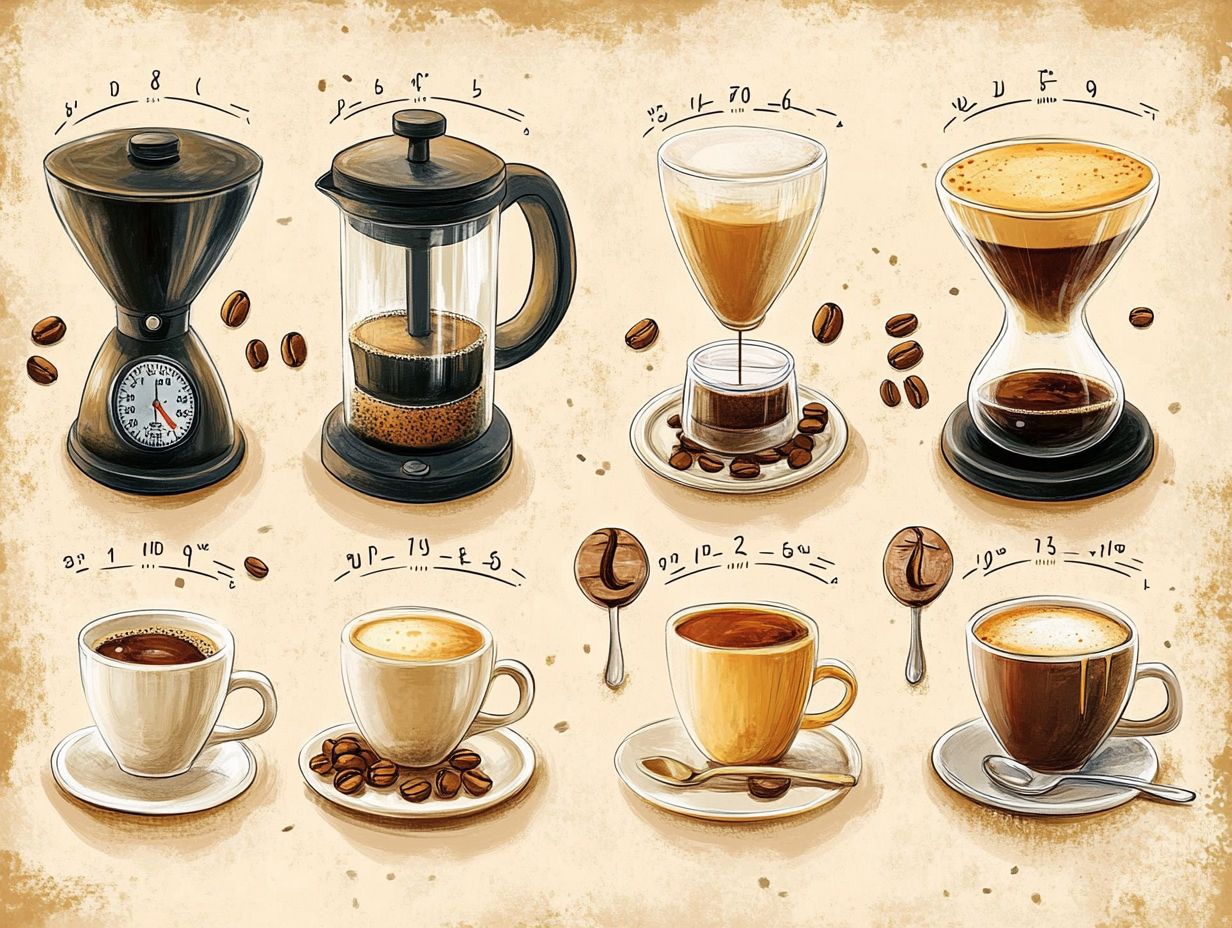
What is the role of coffee roasters in the coffee experience?
Coffee roasters like Onyx Coffee Lab and Huckleberry Coffee Roasters play an essential role by sourcing high-quality beans and perfecting the roast profiles to enhance your coffee experience.
Try experimenting with different brewing methods at home, and share your experiences with friends!
What are some coffee recommendations for different brew methods?
Ruby Coffee Roasters and Dillanos Coffee Roasters are excellent choices due to their diverse bean offerings. For a unique experience, try beans from Colombia, Ethiopia, or Kenya.
What are the different methods for brewing coffee?
Some popular brewing methods include drip, French press, pour-over, cold brew, and espresso. You can also explore Moka Pot, Ibrik, and Vac Pot Syphon.
How do the brewing times vary between these methods?
Brewing times vary significantly. Drip brewing usually takes 5-7 minutes while French press takes about 4 minutes. Pour-over can take 2-3 minutes, but cold brew requires 12-24 hours, and espresso brews in just 20-30 seconds.
Which brewing method is the quickest?
If you re in a hurry, espresso is your best bet! It brews in just 20-30 seconds, especially with a quality espresso machine.
Are there any benefits to using a longer brewing time?
Longer brewing times lead to stronger, richer coffee. This is particularly true for cold brew, which takes 12-24 hours to create a smooth, flavorful cup.
Can I use the same type of coffee for all methods?
You can use the same coffee for all methods, but expect variations in taste and strength. For instance, medium roast works best for drip coffee, while dark roast shines in a French press.
What factors can affect brewing time?
Factors like bean type, grind size, water temperature, and equipment can influence brewing time and taste. Filtering methods and the efficiency of your brewing setup also play essential roles.
Which brewing method do you prefer? Let us know!

